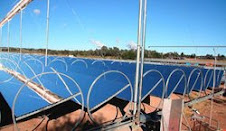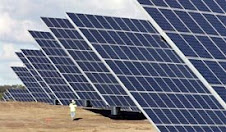Clean Energy: Peering Down China's IPO Pipeline
by Catherine Lacoursiere, RenewableEnergyAccess.com
The Chinese IPO boom appears to be building on strong momentum. Reuters reports that 42 percent of Chinese companies are planning stock issues and over 50 have received approval and plan to go public in 2006. This is good news for clean energy. While investors have devoured shares of Chinese solar gear maker Suntech Power Holdings (NYSE: STP), clean technology IPOs out of China have been sparse.
It is easy to see the attraction to China cleantech. Domestically, renewable energy consumption is growing in excess of 25 percent. Globally, companies like Suntech Power, which exports 90 percent of its production, are enjoying an export boom. Chinese exports are growing at close to 30 percent a year.
Investors will soon see their growing appetite for China new energy satiated. Recent changes in China's capital markets will make it easier for Chinese companies to gain access to financing, both at home and abroad. Up until 2002, the process for a Chinese company to issue an IPO was difficult and required the approval of the China Securities Regulatory Commission (CSRC). Additionally, last year, China halted domestic IPO issuance amidst growing concerns over corporate governance practices. The move also provided a more captive market for the floatation of over $200 billion in shares of Chinese privatized, state-owned companies.
As a result, global exchanges have witnessed an invasion of Chinese IPOs. In 2005, 80 percent of all IPOs on the Hong Kong Stock Exchange were Chinese H-shares. Following Suntech, the New York Stock Exchange now hosts 25 Chinese companies. A few weeks ago, China announced that it is making it easier for small and medium-sized technology enterprises to gain access to domestic capital. Measures to be taken include easing restrictions on the IPO registration process and allowing SMEs to issue bonds. And plans are in the works for a separate stock exchange for smaller companies, similar to London's Alternative Investment Market (AIM).
Don Ye, Director of the Beijing-based China Environment Fund, the leading sustainable investment fund in China, emphasizes that many of the Chinese companies receiving positive receptions on foreign exchanges have a large foreign export base. China benefits from a manufacturing advantage that includes both lower costs and human capital, "Chinese talent," says Ye. The China Environment Fund's second fund, which closed in November, is focusing on renewable energy and energy efficiency technologies.
Investor preference for concrete sales abroad also reflects the murky accounting that was a characteristic of the last Chinese IPO boom in 2001. One such practice involved shell companies acquiring privatized state assets and prepping the new company for sale. Moreover, according to Reuters, Chinese valuations are more in line with expectations today, dropping to 20 times earnings from 60 in 2001.
Going forward, CEF's Ye expects to see more solar issues as clean technology IPO issues from China pickup. "One reason the solar PV market is going well is because the government has given it lots of subsidies." Chinese wind technology, such as advanced blades, is another market benefiting from subsidies and expected to "quickly" pick up over the next couple of years. In addition to large export opportunities, demand in the domestic market is increasing as GDP growth continues to outpace the rest of the world. So far, one CEF portfolio company, Dongjiang Environmental (HKSE: 8230), a hazardous waste company that recovers metals from electronic waste, has gone public. Net profits of China's leading hazardous waste company are increasing at a CAGR of 18 percent a year, according to First Shanghai Securities.
Investors also will follow the momentum -- solar plays in the US market and water purification in Singapore, for instance. With hundreds of Chinese cities facing water shortages, Asian companies with wastewater treatment technology have been flooding the market with IPOs in recent years, particularly the Singapore Exchange due to its higher price-to-earnings ratios. Hyflux (SGX: HYFL.SI), a leading Asian maker of water purification and treatment systems, was the first company to list on the Singapore Stock Exchange in 2001. More recently, the issue of Asia Water Technology, a Chinese water treatment company now headquartered in Singapore, was almost eight times oversubscribed.
As China lifts its 10-month moratorium on domestic IPOs, however, foreign exchanges will not only have to compete harder for China's new issues but also domestic IPOs if China follows through with its intention to launch Chinese depositary receipts (CDRs). Either way, with plans to also open the floodgates to more foreign institutional investors, there will be more investment pipelines to China's clean technologies.
Catherine Lacoursiere is a financial journalist who has covered corporate and personal finance and the energy and environment markets from New York and Silicon Valley for Investor's Business Daily, and publications of the Economist Group and McGraw-Hill Companies. Catherine writes columns and blogs on nanotechnology and clean energy investing for InvestorIdeas.com, the Cleantech Venture Network, and RenewableEnergyStocks.com. Her articles are occasionally published here through special arrangement with RenewableEnergyStocks.com
Best Green Stocks Investing Blog
Subscribe to:
Post Comments (Atom)
Yuya Joe Blog
Lake Ontario Waterkeeper
The Daily Beast -Politics Blog
21stArch.com - 21st Century Architecture
Original Joe College Blog
WikiLeaks Foreign Policy Analysis
AGreenRealtor.com Real Estate Blog - Ecology Energy Efficiency
Best Green Stocks Investing Blog
PV Intell Photovoltaic Solar Stocks Investing
SEARCH Leading Alternative Energy and Ethical Investing websites

Custom Search
Daily Kos
Rare Earth Stocks Research
Patrick MacManus's Blog Peace and Collaborative Development
BeesTreesFrogsElephants.com - Nature and Ecology Blog
Research Green Energy stocks, Clean Energy investing information
Find wind power investing info online, clean energy mutual funds, geothermal stocks, solar energy investments.

Green Energy Investing Network:
Green Stocks Investing Clean Power Blog
SolarIntell.com Renewable Power Investing Website
Wind Intell.com Wind Energy Stocks Company Links
Geothermal Power Investing Public Companies
PV Intell.com Leading Photovoltaic Solar Energy Stocks

Custom Search
Green Energy Investing Network:
Green Stocks Investing Clean Power Blog
SolarIntell.com Renewable Power Investing Website
Wind Intell.com Wind Energy Stocks Company Links
Geothermal Power Investing Public Companies
PV Intell.com Leading Photovoltaic Solar Energy Stocks







No comments:
Post a Comment